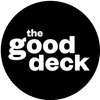What is it?
Concept boards are like the visual blueprint of a presentation. They’re essentially a collection of visuals, typography, color schemes, and sometimes even sample slide layouts that give a client a tangible sense of how the presentation will look and feel before you dive into the detailed design work.
Think of it as a mood board, but with more structure, intention, and detail. It’s about setting the tone and ensuring alignment. You’re showing the client the visual language and the key elements that will make up the presentation.
The beauty of concept boards is that they allow us to test ideas early. We can gauge the client's reactions to different styles, imagery, and visual metaphors without having to design the entire presentation. It’s a strategic checkpoint where we can confirm, 'Hey, is this the right direction?' before investing time in building out all the slides.
They also work as a critical self-reflection and decision-making tool for designers themselves by helping define the bigger picture first. They allow you to step back and think strategically about the visual direction and narrative you want to establish before you get caught up in the nitty-gritty.
Another key advantage is efficiency. By establishing a clear visual direction upfront, you eliminate a lot of trial and error later on. Imagine designing 10 slides only to realize halfway through that the visual style doesn’t fit the message or the brand. That’s a lot of wasted time and effort. With a concept board, you’ve already made those high-level design decisions, so when you do start on the actual slides, you can move forward with confidence and speed, knowing you’re on the right track.
When to use it
- To iterate and refine design concepts quickly without getting caught up in the intricacies of detailed design drafts.
- To allow stakeholders to provide input and feedback at an early stage, eliminating misunderstandings or misinterpretations.
Remember to
- Choose impactful and representative images, typography treatments, and visual aids to convey the essence of your design concept.
- Keep it focused and cohesive: While it's important to explore different design possibilities, ensure that your concept board maintains a clear and coherent direction.
Step-by-step
1 |
Gather inspiration and references Collect inspiration and references that are relevant to the project. This can include existing mood boards, Pinterest boards, existing presentation content, and any other presentations from the client. Also, look for other presentations that are similar in nature, format, or purpose to the project you're working on. |
2 |
Define design elements Identify the key design elements you’ll use in your concept boards. For a presentation concept board, these elements usually include charts, diagrams, typography (fonts and how they work together), color schemes, icons, images, and 1-3 sample layouts. Choose specific design elements that match the content of the presentation. |
3 |
Brainstorm and sketch ideas Start generating design ideas by brainstorming and sketching rough concepts. Don’t worry about making them perfect—focus on capturing the core ideas. Keep the brand’s identity, values, and target audience in mind. Think about details like whether to use rounded corners, solid or gradient fills, and the style of images. |
4 |
Select the strongest concepts Review your sketches and pick the ideas that best match the brand’s goals and visual identity. Select the concepts that most effectively communicate the message you want to deliver. |
5 |
Explore and refine concepts on digital boards Transfer your chosen sketches to digital concept boards. Create separate boards for each concept. Arrange the elements on the boards in a way that is logical and visually appealing, using layout techniques like grids to ensure consistency and balance. |
6 |
Select concepts for client review Choose 2-3 of your best concepts to show to the client. Make sure each one is distinct but still fits within the brand’s guidelines and the presentation’s purpose. |
7 |
Present and discuss Prepare a narrative or explanation for each concept. Clearly describe your thought process, reasoning, and the unique aspects of each design. Present these to the client and encourage discussion to gather their feedback and preferences. |
8 |
Make adjustments and finalize Based on the client’s feedback, make any necessary adjustments to your concept boards. Once the concept is approved, finalize the board, which will guide the rest of the design process. Make any last refinements before moving forward with the project. |


